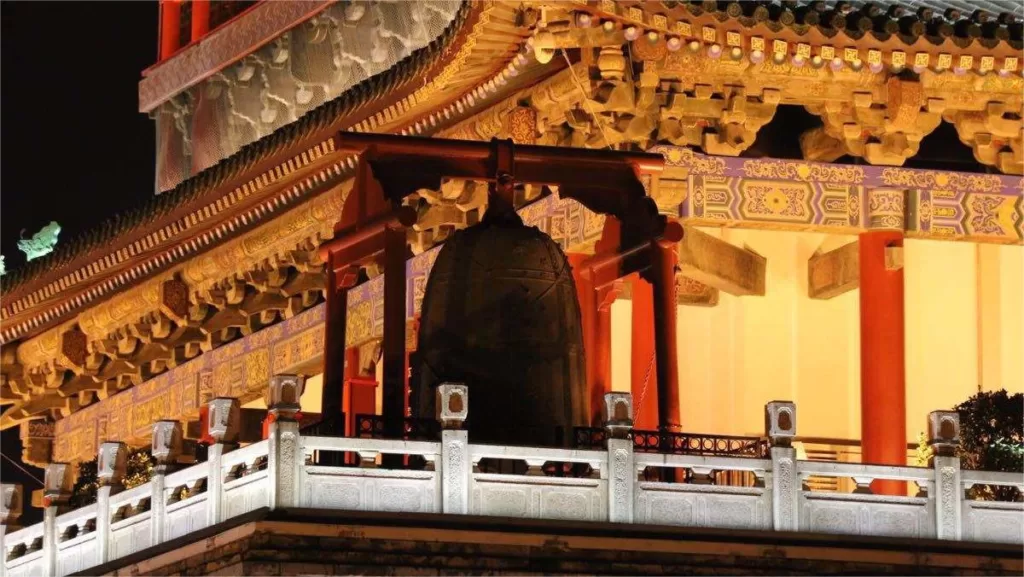La cloche de Jingyun - un ancien symbole du riche patrimoine de Xi'an


In the heart of China’s Shaanxi province lies the majestic city of Xi’an, a place steeped in history and home to some of the country’s most treasured cultural relics. Among these treasures stands the magnificent Jingyun Bell (景云钟), an ancient bell that has become an enduring symbol of Xi’an’s rich heritage. With a history spanning over a thousand years, this extraordinary artifact carries with it tales of imperial grandeur, religious devotion, and the enduring spirit of a bygone era.
The Jingyun Bell, also known as the “Bell of Jingyun Temple,” was originally cast during the Tang Dynasty, one of China’s most prosperous periods, in the year 711. It was created under the supervision of skilled craftsmen and artisans, who painstakingly crafted its bronze body using traditional techniques. The bell’s dimensions are truly awe-inspiring, with a height of 2.47 meters and a weight of approximately 6 tons. Its massive size and intricate detailing reflect the mastery of the craftsmen and their dedication to creating a timeless work of art.
Initially housed within the Jingyun Temple, a Buddhist temple known for its grandeur and significance, the bell played an essential role in religious ceremonies and as a means to summon monks to prayer. The resonant sound produced by the bell was believed to cleanse the soul and promote spiritual enlightenment. For centuries, the Jingyun Bell served as a centerpiece of devotion, casting its melodic tones across the temple grounds and beyond, enveloping the faithful in a sense of tranquility and reverence.
Over time, the Jingyun Bell transcended its religious significance and became a cultural symbol for the people of Xi’an. Its richly decorated surface is adorned with intricate patterns, including dragons, lotus flowers, and celestial guardians. Each motif carries its own symbolic meaning, reflecting the aspirations and beliefs of the ancient Chinese civilization. These ornate engravings make the Jingyun Bell not only a functional instrument but also a masterpiece of artistic expression, showcasing the exceptional craftsmanship and artistic talent of the Tang Dynasty.
Despite its grandeur, the Jingyun Bell’s fate was not always secure. In the turbulent years that followed the Tang Dynasty, the bell was relocated multiple times due to wars and political upheavals. Nevertheless, its significance never waned, and efforts were made to protect and preserve this cultural treasure. Eventually, in 1958, the bell found its permanent home in the Xi’an Bell Tower, a landmark structure located in the city center.
Today, the Jingyun Bell stands as an iconic symbol of Xi’an, drawing visitors from far and wide to witness its majestic presence. The Bell Tower, with the bell at its heart, has become a popular tourist attraction, offering a glimpse into the city’s rich past. Visitors can admire the bell’s impressive size, marvel at its intricate design, and even have the rare opportunity to strike the bell, feeling the vibrations reverberate through their very being.
Moreover, the Jingyun Bell serves as a reminder of the importance of cultural preservation. It represents Xi’an’s commitment to honoring its heritage and safeguarding the legacy of the past for future generations. The bell’s enduring presence is a testament to the resilience and indomitable spirit of the Chinese people, who continue to cherish their traditions and celebrate their history.
In conclusion, the Jingyun Bell stands as a remarkable testament to the grandeur of Xi’an’s cultural heritage. Its immense size, exquisite craftsmanship, and profound historical significance make it a true marvel. As it resonates with the echoes of centuries past, the bell serves as a tangible link to an ancient civilization, inviting us to contemplate the wisdom and beauty of the past. The Jingyun Bell continues to inspire awe and admiration, captivating all who encounter it and leaving an indelible mark on the hearts and minds of those fortunate enough to witness its magnificence.
Faits concernant les sites historiques du Shaanxi